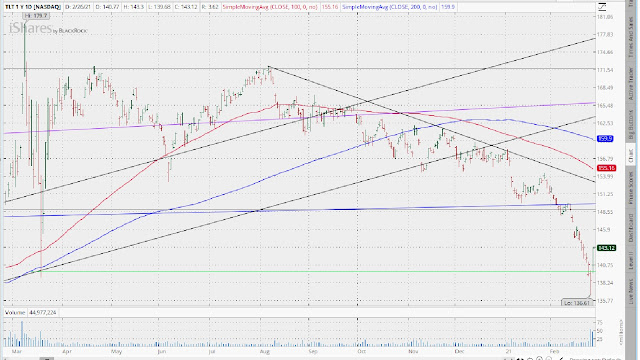The Morning Call
3/1/21
The
Market
Technical
The S&P hit an
air pocket last week. On Thursday, it finished
below the lower boundary of its short term uptrend and remained there through
the close on Friday. If it ends there
today, the short term uptrend will reset to a trading range. Let’s see what happens before speculating on
the meaning. At the moment, nothing has
changed: ‘while valuations continue to reach historical extremes, I can’t see an
end to this uptrend as long as the money keeps flowing with abundance and in
the absence of any major negative exogenous event.’
The long bond rallied
hard on Friday, finishing back above the lower boundary of its very short term
trading range, voiding Thursday’s break.
The question is, was this a dead cat bounce or is that lower boundary
providing good support, marking an end to the current seven month
downtrend? This is, of course, more than
a technical question; it involves investors conviction regarding higher
interest rates/inflation. Again, let’s
see what happens.
Unlike equity and
bond investors, gold investors do not appear to have many doubts about its
direction---and that is down. GLD got
crushed again on Friday. Importantly,
there is no visible support until it reaches the lower boundary of its very
short term uptrend (the upward slopping green line) and that is 10% below
current levels. However, remember, GLD got
overextended to the upside and can fall a good deal before any longer term
technical damage is done.
https://www.zerohedge.com/the-market-ear/c0dyirxmko
https://www.zerohedge.com/markets/bonds-bullion-suffer-worst-month-5-years-commodities-crypto-soar
Fundamental
Headlines
The
Economy
Review of the Week
The US data last
week was positive, including the primary indicators (three plus, one negative). That keeps the string of upbeat stats alive---long
enough that I think safe to conclude that the worst of coronavirus economic disruptions
are behind us.
Still, two
questions. ‘One, will the recovery
accelerate, closing the output gap in a short time or will the economy continue
to struggle to regain its historical secular growth rate? I think that this is the easier question to
answer because I see no reason to alter my assumption that the current grossly
irresponsible monetary and fiscal policies will act as a drag on economic
growth. So, while I expect growth to continue, I do not expect either its rate
of growth to match the levels reached as the economy bounced off the bottom or the
economy to close the existing output gap in the foreseeable future.
https://www.zerohedge.com/markets/redlining-us-economy-growing-fastest-pace-record-goldman-finds
Two,
will or won’t the economic recovery be accompanied by an increase in the inflation
rate that will push it to levels that historically have proven problematic for
both the economy and the securities’ markets?
This issue is a bit tougher to analyze.
At
first blush, it seems reasonable to assume that if economic growth remains
subpar, then there will be few upward price pressures aside for those
temporarily created by the dislocations due to coronavirus government restrictions.
On
the other hand, with the vast amount of liquidity sloshing around the global
economy, commodity prices could respond to speculation (as they appear to be
doing now). Throw in higher labor costs
resulting from an increase in the minimum wage and there is an argument for upward
supply side pressures. At present, I am
not convinced to the merits of this thesis.’
However, with each
passing day, bond investors increasingly are.
That doesn’t mean that they are right.
Plus, Friday’s pin action in the TLT may be indicating that the worst is
over. Patience.
https://www.zerohedge.com/markets/despite-fed-bond-market-hiking-rates
Overseas, the
stats were also positive---which is a plus for the US. Though as I have noted
previously, the recovery in Europe will likely be more anemic than our own.
US
International
The February
Chinese manufacturing PMI came in at 50.6 versus estimates of 51.1; the Chinese
Caixin (small business) manufacturing PMI was 50.9 versus 51.5; the nonmanufacturing
PMI was 51.4 versus 52.4 reported in January.
The February German
manufacturing PMI was reported at 60.7 versus expectations of 60.6; the EU manufacturing
PMI was 57.9 versus 57.7; the UK manufacturing PMI was 55.1 versus 54.9; the Japanese
manufacturing PMI was reported at 51.4 versus 49.8 in December.
February German
CPI was +0.6 versus consensus of +0.5%.
Other
The Fed
Powell changes the rules.
https://www.zerohedge.com/economics/powell-changes-rules-qe
News on Stocks in Our Portfolios
Altria (NYSE:MO) declares
$0.86/share quarterly dividend, in line with previous.
What
I am reading today
Visit Investing
for Survival’s website (http://investingforsurvival.com/home)
to learn more about our Investment Strategy, Prices Disciplines and Subscriber
Service.





No comments:
Post a Comment